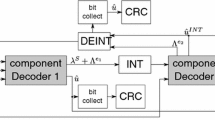Abstract
Maximum A Posteriori (MAP) decoding is a crucial enabler of turbo coding and other powerful feedback-based algorithms. To allow pervasive use of these techniques in resources constrained systems, it is important to limit their implementation complexity, without sacrificing the superior performance they are known for. We show that introducing traceback information into the MAP algorithm, thereby leveraging components that are also part of Soft-Output Viterbi Algorithms (SOVA), offers two unique possibilities to simplify the computational requirements. Our proposed enhancements are effective at each individual decoding iteration and therefore provide gains on top of existing techniques such as early termination and memory optimizations. Based on these enhancements, we will present three new architectural variants for the decoder. Each one of these may be preferable depending on the decoder memory hardware requirements and number of trellis states. Computational complexity is reduced significantly, without incurring significant performance penalty.











Similar content being viewed by others
Notes
These numbers directly follow from equations (2)-(7). The branch metric calculation results in three additions, see reference [9], equations (4)-(5).
A MAX can be implemented as a slightly simplified ADD followed by a multiplexer, and is roughly comparable in terms of energy consumption [9]. The number of traceback operations is small in each one of the cases and the approximation as one equivalent operation therefore does not impact the overall comparison to a large degree.
References
Technical Specification Group Radio Access Network; Multiplexing and channel coding (FDD), 3rd Generation Partnership Project (3GPP), TS 25.212 v5.0.0, http://www.3gpp.org.
Physical layer standards for cdma2000 spread spectrum systems, 3rd Generation Partnership Project 2 (3GPP2), ARIB STD-T64-C.S20002-A, http://www.3gpp2.org.
Thul, M., Vogt, T., Gilbert, F., & Wehn, N. (2002). Evaluation of algorithm optimizations for low-power turbo-decoder implementations. In Proc. IEEE ICASSP’02, Orlando, FL, pp.III-3101–4.
Garrett, D., Xu, B., & Nicol (2001). Energy efficient turbo decoding for 3G mobile. In Proc. ACM/IEEE ISLPED’01, Huntington Beach, CA, pp. 328–33.
Fossorier, M., Burkert, F., Lin, S., & Hagenauer, J. (1998). On the equivalence between SOVA and Max-Log-MAP decodings. IEEE Communications Letters, 2(5), 137–139.
Vogt, J., & Finger, A. (2000). Improving the max-log-MAP turbo decoder. Electronics Letters, 36(23), 1937–1939.
Benedetto, S., Divsalar, D., Montorsi, G., & Pollara, F. (1997). A soft-input soft-output APP module for iterative decoding of concatenated codes. IEEE Communications Letters, 1(1), 22–24.
Forney, G. (1973). The viterbi algorithm. Proceedings IEEE, 61, 268–278.
Schurgers, C., Catthoor, F., & Engels, M. (2001). Memory optimization of MAP turbo decoder algorithms. IEEE Transactions on VLSI Systems, 9(2), 305–312.
Benedetto, S., Divsalar, D., Montorsi, G., & Pollara, F. (1996). Algorithm for continuous decoding of turbo codes. Electronics Letters, 32(4), 314–315, Feb.
Robertson, P., Villebrun, E., & Hoeher, P. (1995). A comparison of optimal and sub-optimal MAP decoding algorithms operating in the log domain. Proc. International Conference on Communications (ICC’95), Seattle, Washington, pp. 1009–1013.
Berrou, C., Glavieux, A., & Thitimajshima, P. (1993). Near Shannon limit error-correcting coding and decoding: Turbo-codes. Proc. International Conference on Communications (ICC’93), Geneva, Switzerland, pp. 1064–1070.
Wang, Z., Suzuki, H., & Parhi, K. K. (2001). Finite wordlength analysis and adaptive decoding for turbo/MAP decoders. Journal of VLSI Signal Processing, 29(3), 209–221, November.
Worm, A., Michel, H., Kreiselmaier, G., Thul, M., & Wehn, N. (2000). Advanced implementation issues of turbo-decoders. Proc. 2nd International Symposium on Turbo-Codes and Related Topics, Brest, France, pp. 351–354.
Kaza, J., & Chakrabarti, C. I. (2004). Design and implementation of low-energy turbo decoders. IEEE Transactions on Very Large Scale Integration Systems, 12(9), 968–977.
Hagenauer, J., & Papke, L. (1994). Decoding ‘turbo’-codes with the Soft Output Viterbi Algorithm (SOVA). Proc. of IEEE Int. Symposium on Information Theory (ISIT’94), Trondheim, Norway, p. 164.
Halter, S., Öberg, M., Chau, P., & Siegel, P. (1998). Reconfigurable signal processor for channel coding & decoding in low SNR wireless communications. Proc. IEEE Workshop on Signal Processing Systems (SiPS’98), Cambridge, MA, pp. 260–274.
Garrett, G., & Stan, M. (1998). Low power architecture of the Soft-Output Viterbi Algorithm. Proc. International Symposium on Low Power Electronics and Design, Monterey, CA, pp. 262–267.
Masera, G., Mazza, M., Piccinini, G., Viglione, F., & Zamboni, M. (2002). Architectural strategies for low-power VLSI turbo decoders. IEEE Transactions on VLSI Systems, 10(3), 279–285, June.
Worm, A., Lamm, H., & Wehn, N. (2001). Design of low-power high-speed maximum a posteriori decoder architectures. Proc. Design, Automation and Test in Europe (DATE’01), Munich, Germany, pp. 258–265.
Gross, W., & Gulak, G. (1998). Simplified MAP algorithm suitable for implementation of turbo decoders. Electronics Letters, 34(16), 1577–1578.
Boutillon, E., Gross, W., & Gulak, G. (2003). VLSI architectures for the MAP algorithm. IEEE Transactions on Communications, 51(2), 175–185.
Wang, Z., Chi, Z., & Parhi, K. (2002). Area-efficient high-speed decoding schemes for turbo decoders. IEEE Transactions on VLSI Systems, 10(6), 902–912.
Wu, C.-M., Shieh, M.-D., Wu, C.-H., Hwang, Y.-T., & Chen, J.-H. (2005). VLSI architectural design tradeoffs for sliding-window log-MAP decoders. Transactions on VLSI Systems, 13(4), 439–447.
Tiwari, M., Zhu, Y., & Chakrabarti, C. (2005). Memory sub-banking scheme for high throughput MAP-based SISO decoders. IEEE Transactions on VLSI Systems, 13(4), 494–498.
Engin, N. (2004). A turbo decoder architecture with scalable parallelism. Proc. Workshop on Signal Processing Systems (SIPS’04), Austin, TX, pp. 298–303.
Li, F.-M., Shen, P.-L., & Wu, A.-Y. (2004). Unified convolutional/turbo decoder architecture design based on triple-mode MAP/VA kernel. Processing Asia-Pacific Conference on Circuits and Systems, 2, 1073–1076.
Elassal, M., & Bayoumi, M. (2004). VLSI MAP decoder architectural analysis. Proc. Workshop on Signal Processing Systems (SIPS’04), Austin, TX, pp. 292–297.
Cavallaro, J., & Vaya, M. (2003). Viturbo: a reconfigurable architecture for Viterbi and turbo decoding. Proc. ICASSP’03, pp. II-497–500.
Schurgers, C., & Chandrakasan, A. (2004). Traceback-enhanced MAP decoding algorithm. Proc. International Conference on Acoustics, Speech, and Signal Processing (ICASSP'04), Montreal, Canada, pp. IV.645–IV.648.
Author information
Authors and Affiliations
Corresponding author
Rights and permissions
About this article
Cite this article
Schurgers, C., Chandrakasan, A. Traceback-Based Optimizations for Maximum a Posteriori Decoding Algorithms. J Sign Process Syst Sign Image Video Technol 53, 231–241 (2008). https://doi.org/10.1007/s11265-007-0160-8
Received:
Accepted:
Published:
Issue Date:
DOI: https://doi.org/10.1007/s11265-007-0160-8




